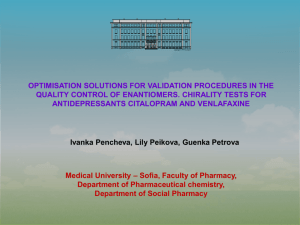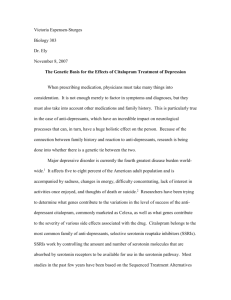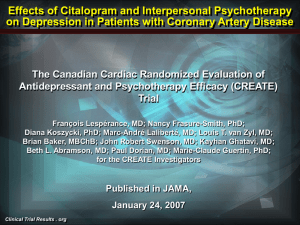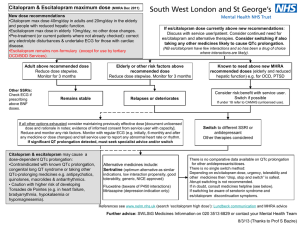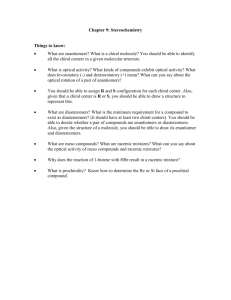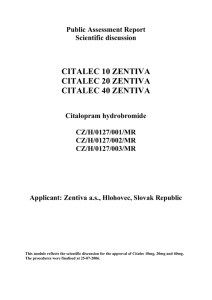Document 13309021
advertisement
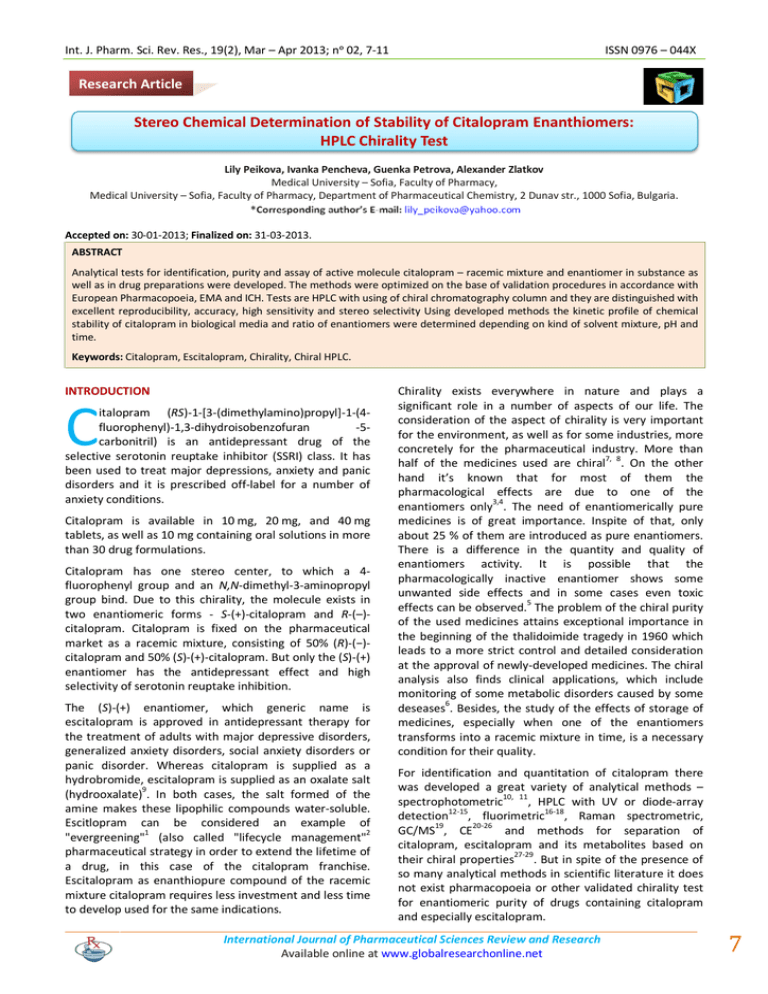
Int. J. Pharm. Sci. Rev. Res., 19(2), Mar – Apr 2013; nᵒ 02, 7-11 ISSN 0976 – 044X Research Article Stereo Chemical Determination of Stability of Citalopram Enanthiomers: HPLC Chirality Test Lily Peikova, Ivanka Pencheva, Guenka Petrova, Alexander Zlatkov Medical University – Sofia, Faculty of Pharmacy, Medical University – Sofia, Faculty of Pharmacy, Department of Pharmaceutical Chemistry, 2 Dunav str., 1000 Sofia, Bulgaria. Accepted on: 30-01-2013; Finalized on: 31-03-2013. ABSTRACT Analytical tests for identification, purity and assay of active molecule citalopram – racemic mixture and enantiomer in substance as well as in drug preparations were developed. The methods were optimized on the base of validation procedures in accordance with European Pharmacopoeia, EMA and ICH. Tests are HPLC with using of chiral chromatography column and they are distinguished with excellent reproducibility, accuracy, high sensitivity and stereo selectivity Using developed methods the kinetic profile of chemical stability of citalopram in biological media and ratio of enantiomers were determined depending on kind of solvent mixture, pH and time. Keywords: Citalopram, Escitalopram, Chirality, Chiral HPLC. INTRODUCTION C italopram (RS)-1-[3-(dimethylamino)propyl]-1-(4fluorophenyl)-1,3-dihydroisobenzofuran -5carbonitril) is an antidepressant drug of the selective serotonin reuptake inhibitor (SSRI) class. It has been used to treat major depressions, anxiety and panic disorders and it is prescribed off-label for a number of anxiety conditions. Citalopram is available in 10 mg, 20 mg, and 40 mg tablets, as well as 10 mg containing oral solutions in more than 30 drug formulations. Citalopram has one stereo center, to which a 4fluorophenyl group and an N,N-dimethyl-3-aminopropyl group bind. Due to this chirality, the molecule exists in two enantiomeric forms - S-(+)-citalopram and R-(–)citalopram. Citalopram is fixed on the pharmaceutical market as a racemic mixture, consisting of 50% (R)-(−)citalopram and 50% (S)-(+)-citalopram. But only the (S)-(+) enantiomer has the antidepressant effect and high selectivity of serotonin reuptake inhibition. The (S)-(+) enantiomer, which generic name is escitalopram is approved in antidepressant therapy for the treatment of adults with major depressive disorders, generalized anxiety disorders, social anxiety disorders or panic disorder. Whereas citalopram is supplied as a hydrobromide, escitalopram is supplied as an oxalate salt (hydrooxalate)9. In both cases, the salt formed of the amine makes these lipophilic compounds water-soluble. Escitlopram can be considered an example of "evergreening"1 (also called "lifecycle management"2 pharmaceutical strategy in order to extend the lifetime of a drug, in this case of the citalopram franchise. Escitalopram as enanthiopure compound of the racemic mixture citalopram requires less investment and less time to develop used for the same indications. Chirality exists everywhere in nature and plays a significant role in a number of aspects of our life. The consideration of the aspect of chirality is very important for the environment, as well as for some industries, more concretely for the pharmaceutical industry. More than half of the medicines used are chiral7, 8. On the other hand it’s known that for most of them the pharmacological effects are due to one of the enantiomers only3,4. The need of enantiomerically pure medicines is of great importance. Inspite of that, only about 25 % of them are introduced as pure enantiomers. There is a difference in the quantity and quality of enantiomers activity. It is possible that the pharmacologically inactive enantiomer shows some unwanted side effects and in some cases even toxic effects can be observed.5 The problem of the chiral purity of the used medicines attains exceptional importance in the beginning of the thalidoimide tragedy in 1960 which leads to a more strict control and detailed consideration at the approval of newly-developed medicines. The chiral analysis also finds clinical applications, which include monitoring of some metabolic disorders caused by some 6 deseases . Besides, the study of the effects of storage of medicines, especially when one of the enantiomers transforms into a racemic mixture in time, is a necessary condition for their quality. For identification and quantitation of citalopram there was developed a great variety of analytical methods – spectrophotometric10, 11, HPLC with UV or diode-array detection12-15, fluorimetric16-18, Raman spectrometric, 19 20-26 GC/MS , CE and methods for separation of citalopram, escitalopram and its metabolites based on 27-29 their chiral properties . But in spite of the presence of so many analytical methods in scientific literature it does not exist pharmacopoeia or other validated chirality test for enantiomeric purity of drugs containing citalopram and especially escitalopram. International Journal of Pharmaceutical Sciences Review and Research Available online at www.globalresearchonline.net 7 Int. J. Pharm. Sci. Rev. Res., 19(2), Mar – Apr 2013; nᵒ 02, 7-11 MATERIALS AND METHODS Chromatographic system The chromatographic procedure was carried out using: special fixed chiral column was applied. The method is distinguished with wide range based on possibility to achieve the optimal values of analytical parameters, high performance and stereo selectivity. There was used stationary phase in which to basic packing ODS (octadecylsilan) (S)-valine and (R)-1-(αnaphthyl)ethylamine urea are added. They are playing the role of electron donor substances and they are able to bind at different positions in the packing substance molecule both enantiomers – Fig. 1. Liquid chromatograph Shimadzu LC – 10, Phenomenex Columns: Chirex 3126 and 250 x 4.60 mm, ODS with particle size 5 µm; Detector SPD 10 AVvp – UV-VIS with fixed analytical wavelengths. O Si (CH2)3 O CH3 Chromatographic conditions - 230 nm analytical wavelengths; - column temperature 25ᵒC; - flow rate about 1.5 ml/min. Reagents Acetonitril HPLC grade, Methanol HPLC grade, Buffer solution with pH = 2.0, prepared by European Pharmacopoeia 7.0, Reagents; Buffer solution with pH = 7.4, prepared by European Pharmacopoeia 7.0, Reagents; Buffer solution with pH = 9.0, prepared by European Pharmacopoeia 7.0, Reagents, reference substances citalopram (CRS) and escitalopram CRS. Preparation of reference solutions Reference solutions were prepared by dissolving and mixing of adequate and equal amounts of CRS substances in mobile phase to obtain solutions with concentration 0.00002 mg/ml. Test preparation CH3 With these chiral column in solvent mixture methanol – acetonitrile (55 : 45 v/v) was achieved resolution between two enantiomers 0.42 and at obtained limits - 9 µg for limit of detection and 15 µg for limit of quantitation the system suitable test is valid. On fig. 2 is shown chromatogram of (RS) Citalopram in solvent – methanol – acetonitrile (55 : 45 v/v) obtained with column Chirex at 230 nm. In analogue chromatogram (fig. 3) obtained with other column - 4.6 x 150 mm RP-18, ODS, 5 mm particle size the resolution is slight (near 0) and this method can’t find an application in identification and purity tests. mV(x0.1) Detector A:230nm 5.0 0.0 0.0 To a sample containing 0,0010 mg citalopram racemic mixture (RS) was added 50.0 ml buffer solution with pH 2 or 7.4 or 9. The obtained test solution was heated at fixed temperature 370 C and continuously stirring. In time aliquot portion of the sample is taken and injected into the chromatograph. The study was prolonged to the obtaining of unchangeable remainder. CH CH3 Figure 1: Structure of binding chiral packing. 1 .6 1 2 Isocratic mobile phase, prepared by mixing of filtered and degassed Metanol - Acetonitrile : 55:45 v/v respectively; (R) (S) NHCO CH NHCONH CH 3 .0 5 1 The aim of this study is the investigation of analytical and chromatographic parameters and conditions to develop HPLC chirality test for simultaneously determination of two enantiomeric forms of citalopram with wide range of application but especially for quality control of drugs and for studying of chemical stability in different media. ISSN 0976 – 044X 2.5 5.0 7.5 min Figure 2: Chromatogram of (RS) Citalopram in solvent – methanol – acetonitril (55 : 45 v/v) obtained with column Chirex at 230 nm. 20 mV Detector A:230nm RESULTS AND DISCUSSION The question of chiral purity in the process of generic production of the drug preparation is very debatable because of presence of a patent protection of every single enantiomer. By these reason the development of analytical methods for determination of biological active enantiomers is very important for generic as well as for original producers in order to safe patent rights. For stereo chemical analysis of citalopram – racemic mixture and enantiomers direct HPLC method with 10 0 0.0 2.5 5.0 7.5 min Figure 3: Chromatogram of (RS) Citalopram in solvent – methanol – acetonitrile (55 : 45 v/v) obtained with column 4.6 x 150 mm RP-18, ODS, 5 mm at 230 nm. International Journal of Pharmaceutical Sciences Review and Research Available online at www.globalresearchonline.net 8 Int. J. Pharm. Sci. Rev. Res., 19(2), Mar – Apr 2013; nᵒ 02, 7-11 ISSN 0976 – 044X Validation of analytical procedure 6. System suitability test 1. Specificity For system suitability test determination some chromatographic parameters such as retention time, resolution, LOD and LOQ were appointed for optimization of conditions at different mobile phases. At mobile phase Methanol/Acetonitrile (55 : 45 v/v) and flow rate about 1ml/min the resolution of enantiomers in (RS) citalopram is better than at the mobile phase Methanol/Acetonitrile (70 : 30 v/v) but the change of flow rate effects higher column efficiency – from 2840 to 6200 theoretical plates which is more suitable in assay and purity tests. Specificity in respect of reagents – “Placebo” solution containing all reagents without active substances was prepared. There are no peaks in the chromatogram obtained from this solution with Rt of R-(–) and S-(+) citalopram. 2. Repeatability Six (6) equal solutions from homogenous samples containing (RS) citalopram were analyzed by HPLC method. Standard deviation (SD) is about 2040 AU (absorption units) from area and relative SD (RSD) is 5.56 %. 3. Limit of detection (LOD) 9 µg for citalopram, established on the base of ratio noise – signal – 1:3. 4. Limit of quantitation (LOQ) 15 µg for citalopram, established on the base of ratio noise – signal – 1:10. 5. Linearity The analytical parameter linearity was studied in concentration ratio 9 µg – 2 mg. The accordance between the Area of peaks, measured in absorption units (AU) and concentrations in g/ml is proportional in the intervals. The correlation coefficients was found to be about 0.98853 for (RS) citalopram – Fig. 4. 45000 Area (AU) Linearity of Citalopram 40000 Chemical stability profile Developed chromatographic procedure includes identification test against reference substances citalopram and escitalopram, purity test and assay. The chemical stability of analytes in different media – solvent mixtures and buffer solutions with appropriate biological pH values - 2, 7.4 and 9 was studied and the ratio of too enantiomers was determinate in dependence on kind of solvents and time. The obtained results as % of R-(–) and S-(+) citalopram are presented on table 1. The identification is based on comparison of Rt of analyte with those of reference substance. The retention time and the areas of the citalopram peaks corresponded to that observed in the chromatogram of the reference solution. Table 1: Content in % of R-(–) и S-(+) citalopram at different solvent media Solvent mixture Time (min) % R-(–)citalopram % S-(+)citalopram Mobile phase 0 – 50 52 48 Buffer solution with рН = 2 0 - 120 - 94.11 – 102.27 0 - 95 30 50 33 60 50 27 90 50 27 120 44 27 180 48 22 210 63 - 240 52 - 270 62 - 300 55 - 330 65 - 0 - 180 - 94 – 100 % 35000 30000 Buffer solution with рН = 9 25000 20000 0.000000.000020.000040.000060.000080.000100.000120.000140.00016 C (g/ml) Figure 4: Linearity of citalopram Y = A + B * X (Citalopram) Parameter Value Error -----------------------------------------------------------A 23317.40541 1088.28466 B 1.5468E8 1.3645E7 -----------------------------------------------------------R SD N P -----------------------------------------------------------0.98853 1644.13829 5 0.00147 Buffer solution with рН = 7.4 In acid media and at pH = 7.4 (RS) citalopram has been hydrolyzed for period of 240 min. It spontaneously transforms in S-(+)- enantiomer form which is biological active form and the % of this compound to total racemic mixture putted in the buffer solutions is about 100 % (Fig. 5). In organic solvent mixture Methanol/Acetonitrile (55 : 45 v/v) (RS) citalopram is stable in interval of 50 min International Journal of Pharmaceutical Sciences Review and Research Available online at www.globalresearchonline.net 9 Int. J. Pharm. Sci. Rev. Res., 19(2), Mar – Apr 2013; nᵒ 02, 7-11 and the ratio between both enantiomers is approximately equal and correspond exactly to ratio in the original molecule citalopram – 1: 1. In alkaline media obtained with boric buffer (pH = 9) the both enantiomers appear in the chromatogram but the ratio between than varies in the all observed time interval. At first minute in alkaline media is detected only S-(+)- enantiomer (95 %), and after 180 min - only R-(-)- enantiomer which has negligible biological action. The total quantity is’t responded to putted amount of (RS) citalopram. There were found decomposed related substances – Fig. 6. 2 .2 5 4 / 1 7 1 2 9 2 7 mV(x10) Detector A:230nm 5.0 4.0 3.0 2.0 1.0 ISSN 0976 – 044X 2. "New drugs from old". Drug and Therapeutics Bulletin; 44:73-77; (BMJ Publishing Group Ltd.) 44: 73–77. 2006. doi:10.1136/dtb.2006.441073. http://dtb.bmj.com/cgi/content/abstract/44/10/73?maxt oshow=&HITS=10&hits=10&RESULTFORMAT=&fulltext=es citalopram&searchid=1&FIRSTINDEX=0&sortspec=relevan ce&resourcetype=HWCIT. 3. Aboul-Enein H, Ali I. Chiral Separations by Liquid Chromatography and Related Technologies, Dekker, New York, 2003. 4. Allenmark S. Chromatographic Enantioseparation, Methods and Applications, 2nd edn., Ellis Horwood, New York, 1991. 5. Ariens E J, Sodijn W. Timmermans PBMWM. Stereochemistry and Biological Activity of Drugs. Blackwell Scientific publications Oxford, 1983. 6. Beesley T E, Scott R P W. Chiral Chromatography, Wiley, New York, 1998. 7. ICH harmonized Tripartite Guideline, Validation of analytical procedures: Methodology, 6 November 1996, 1 – 8. 8. ICH, Guideline for industry, Text of validation of Analytical procedures, March 1995, 1 – 4, A1 – A3. 9. www.Celexa.com 10. Narayana B, Veena K. Spectrophotometric Determination of Citalopram Hydrobromide in Pharmaceuticals. J. Mex. Chem., 54, 2010, 98-102. 11. Raza A, Ansari T M, Niazi S B. Spectrophotometric determination of citalopram in pharmaceutical formulation. J. Chem. Soc. Pakistan., 30, 2008, 241-250. 12. Akerman K K, Jolkkonen J, Huttunen H, Penttila I. Highperformance liquid chromatography method for analysing citalopram and desmethylcitalopram from human serum. Ther. Drug Monit., 20, 1998, 25-29. 13. Trachta G, Sägmüller B, Brehm G, Schneider S. Combination of high-performance liquid chromatography and SERS detection applied to the analysis of drugs in human blood and urine J. Mol.Struct., 693, 2004, 175-179. 14. Frahnert C, Rao M L, Grasmader K. Analysis of eighteen antidepressants, four atypical antipsychotics and active metabolites in serum by liquid chromatography: a simple tool for therapeutic drug monitoring. J. Chromatogr. B., 794, 2003, 35-42. 15. Tournel G, Houdret N, Hedouin V, Deveaux M, Gosset D, Lhermitte M. High-performance liquid chromatographic method to screen and quantitate seven selective serotonin reuptake inhibitors in human serum. J. Chromatogr. B., 761, 2001, 147-156. 16. Kristoffersen L, Bugge A, Lundanes E, Slørdal L. Simultaneous determination of citalopram, fluoxetine, paroxetine and their metabolites in plasma and whole blood by high-performance liquid chromatography with ultraviolet and fluorescence detection J. Chromatogr. B., 734, 1999, 229-246. 17. Lacassie E, Gaulier J M, Marquet P, Rabatel J F, Lachatre G. Methods for the determination of seven selective serotonin reuptake inhibitors and three active 0.0 0.0 1.0 2.0 3.0 4.0 5.0 6.0 7.0 8.0 9.0 min 0.5 0.0 3 .0 3 6 /2 6 3 8 4 1.0 2 .4 8 4 /3 0 6 9 mV Detector A:230nm 1 .5 8 3 /3 1 5 2 9 Figure 5: Chromatogram of (RS) citalopram in solvent – buffer solution with pH = 2 and column Chirex. -0.5 0.0 1.0 2.0 3.0 4.0 5.0 6.0 7.0 8.0 9.0 min Figure 6: Chromatogram of (RS) citalopram in solvent – buffer solution with pH = 9 and column Chirex. CONCLUSION Stereo selective HPLC methods are useful for analytical and toxicological practice and for regulatory institutions for quality control of novel generic drugs. Chiral HPLC method for analysis of racemic mixture citalopram gives also possibilities for answering of very debatable in the area of the patent justice and intellectual property questions about the ingenious of chiral molecule and chances for manifestation of it properties. Acknowledgement: This work was supported by Grant from the Council of Medicinal Science at Medical University – Sofia. REFERENCES 1. "New drugs from old. Presented at the Medical Journal Club, Morriston Hospital by Scott Pegler, Pharmacist at the National Health Service (UK) on November 20, 2006" (PPT). http://www.pharmedout.org/Pegler_New_Drugs_From_ Old_Nov2006.ppt. Retrieved 2007-04-07. International Journal of Pharmaceutical Sciences Review and Research Available online at www.globalresearchonline.net 10 Int. J. Pharm. Sci. Rev. Res., 19(2), Mar – Apr 2013; nᵒ 02, 7-11 metabolites in human serum using high-performance liquid chromatography and gas chromatography. J. Chromatogr. B Biomed. Sci. Appl., 742, 2000, 229-238. 18. 19. 20. Macek J, Ptacek P, Klima J. Rapid determination of citalopram in human plasma by high-performance liquid chromatography. J. Chromatogr. B Biomed. Sci. Appl., 755, 2001, 279-285. Frahnert C, Rao M L, Grasmader K. Analysis of eighteen antidepressants, four atypical antipsychotics and active metabolites in serum by liquid chromatography: a simple tool for therapeutic drug monitoring. J. Chromatogr. B Analyt. Technol. Biomed., Life Sci. 794, 2003, 35-47. Kosel M, Eap C B, Amey M, Baumann P. Analysis of citalopram and its demetylated metabolites using hiral liquid chromatography. J. Chromatogr. B., 719, 1998, 234248. 21. Labat L, Deveaux M, Dallet P, Dubost J P. Separation of new antidepressants and their metabolites by micellar electrokinetic capillary chromatography. J. Chromatogr. B Analyt. Technol. Biomed. Life Sci. 773, 2002, 17-23. 22. Halvorsen T G, Pedersen-Bjergaard S, Ramussen K E. Liquid-phase microextraction combined with capillary electrophoresis, a promising tool for the determination of chiral drugs in biological matricesJ. Chromatogr.A., 909, 2001, 87-94. 23. Flores J R, Nevado J J B, Salcedo A M C, Diaz M P C. Development and validation method fordetermination of paroxetine and its metabolites by nonaqueous capillary electrophoresis in human urine. Experimental design for evaluating the ruggedness of the method., Electrophoresis, 25, 2004, 454–462. ISSN 0976 – 044X 24. Andersen S, Halvorsen T G, Pedersen-Bjergaard S, Rasmussen K E. Liquidphase microextraction combined with capillary electrophoresis, a promising tool for the determination of chiral drugs in biological matrices. J. Chromatogr., 963, 2002, 303-312. 25. Andersen S, Halvorsen T G, Pedersen-Bjergaard S, Rasmussen K E, Tanum L, Refsum H. Stereospecific determination of citalopram and desmethylcitalopram by capillary electrophoresis and liquid-phase microextraction. J. Pharm. Biomed. Anal., 33, 2003, 263273. 26. Buzinkaiová T, Polonský J. Determination of four selective serotonin reuptake inhibitors by capillary isotachophoresis. J. Electrophoresis., 21, 2000, 2839-2841. 27. Greiner C, Hiemke C, Bader W, Haen E. Determination of citalopram and escitalopram together with their active main metabolites desmethyl(es-)citalopram in human serum by column-switching high performance liquid chromatography (HPLC) and spectrophotometric detection. J Chromatogr B Analyt Technol Biomed Life Sci., 1, 2007, 848-860. 28. El-Gindy A, Emara S, Mesbah M K, Hadad G M. Liquid chromatography determination of citalopram enantiomers using β-cyclodextrin as a chiral mobile phase additive. J. AOAC Int., 89, 2006, 65-70. 29. Berzas Nevado J J, Guiberteau Cabanillas C, Villaseñor Llerena M J, Rodríguez Robledo V. Enantiomeric determination, validation and robustness studies of racemic citalopram in pharmaceutical formulations by capillary electrophoresis. J Chromatogr A. 29, 2005, 1072, 249-257. Source of Support: Nil, Conflict of Interest: None. International Journal of Pharmaceutical Sciences Review and Research Available online at www.globalresearchonline.net 11
